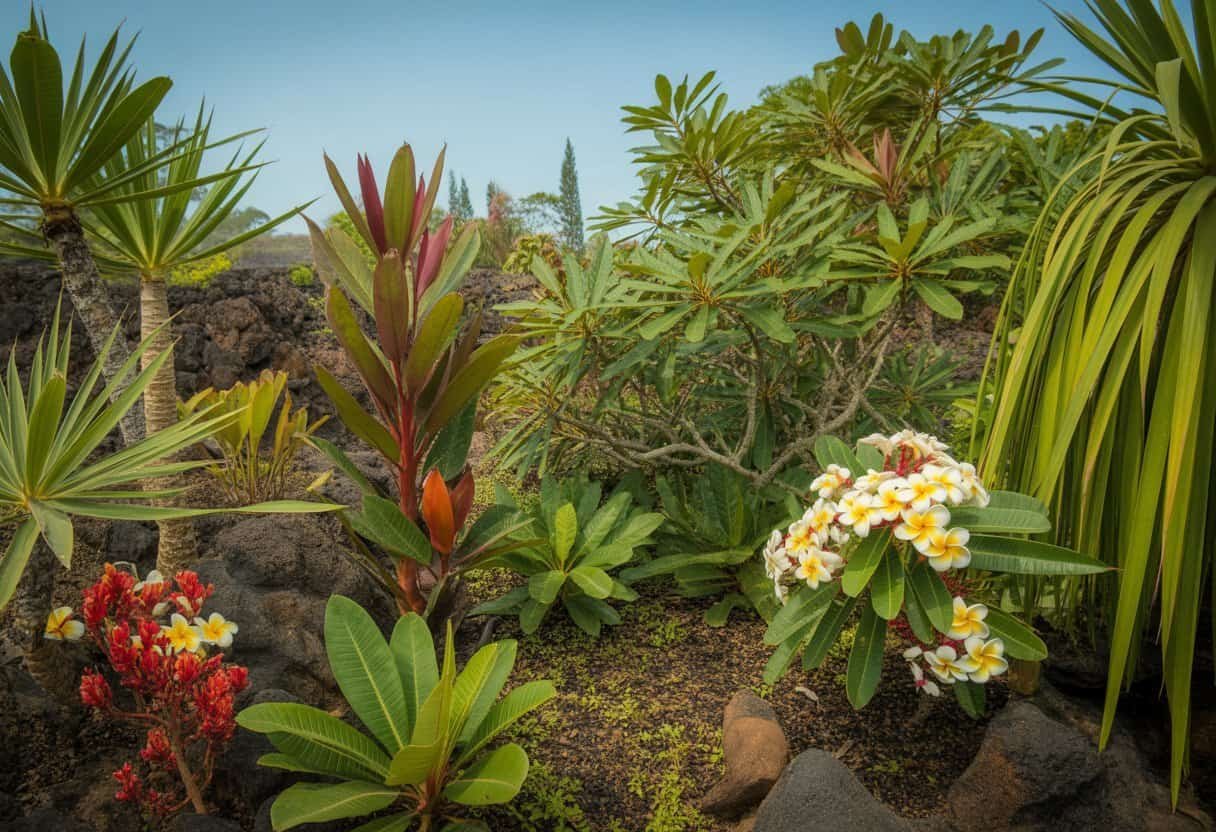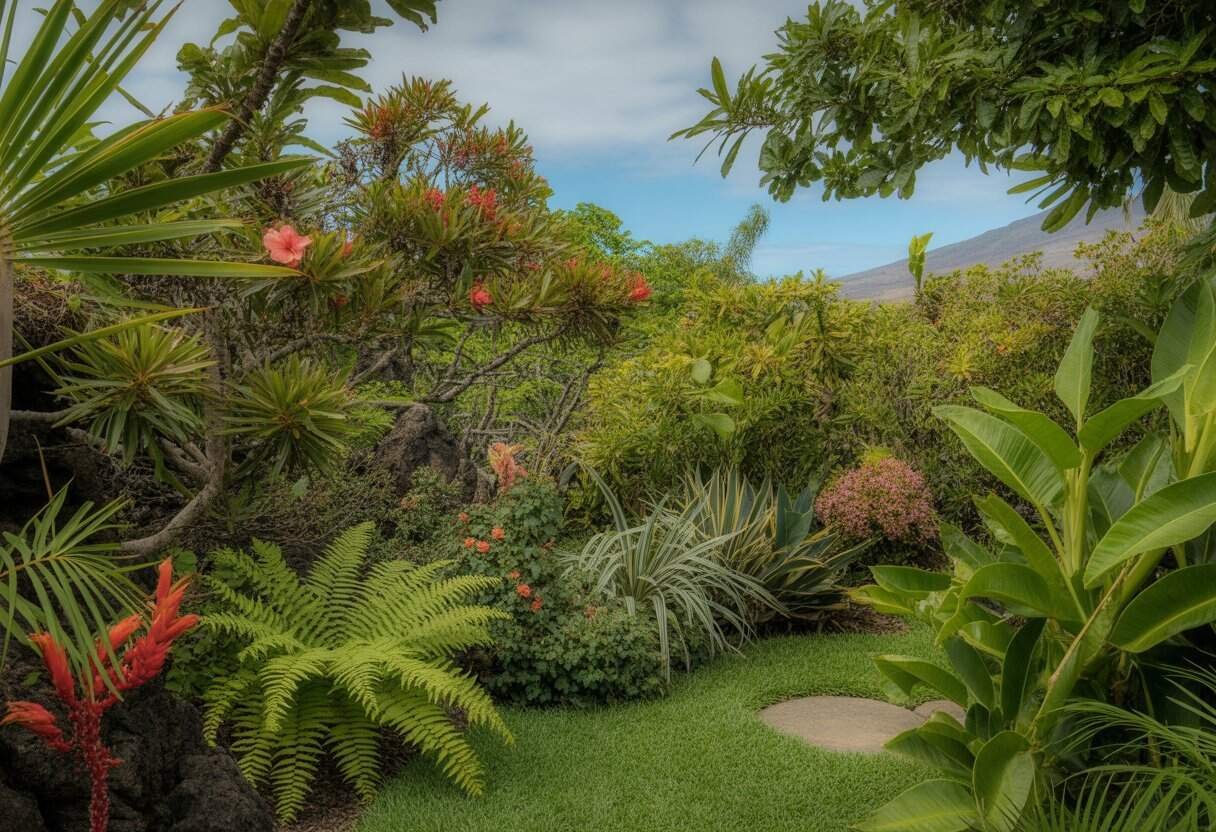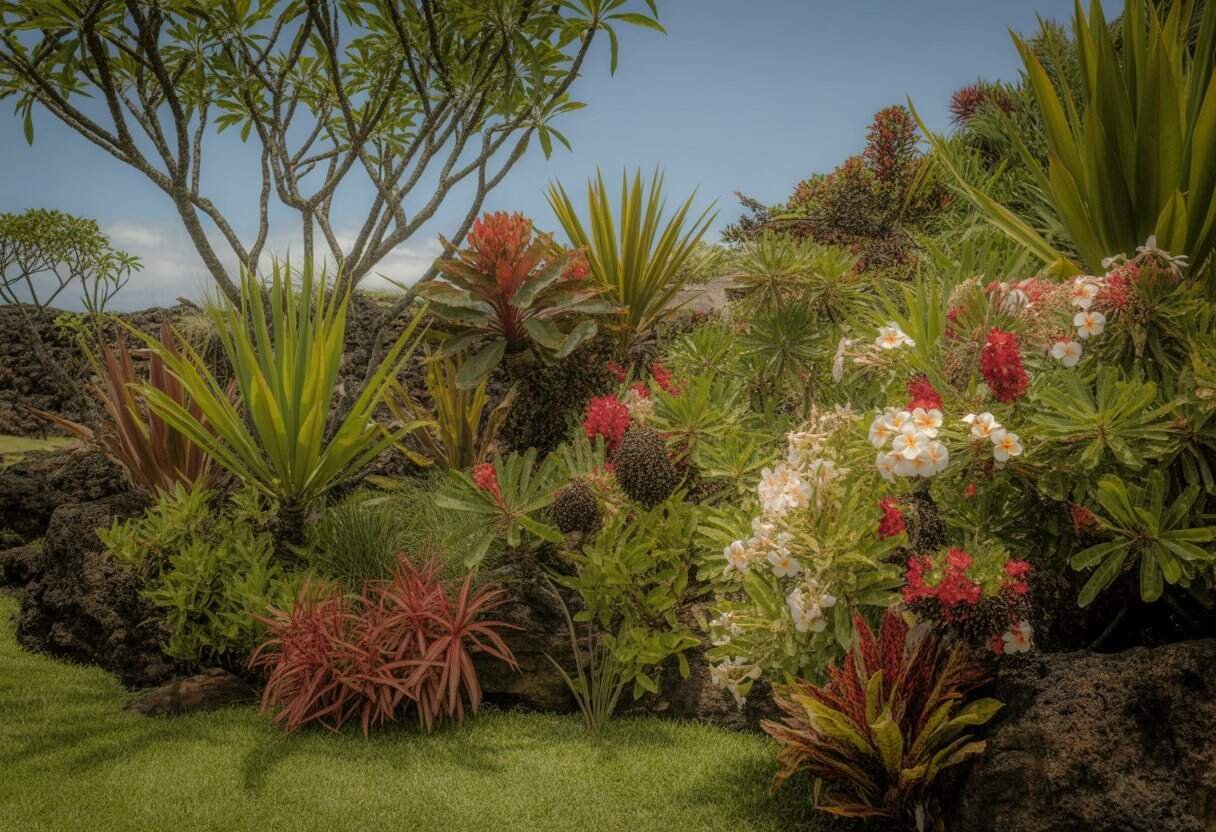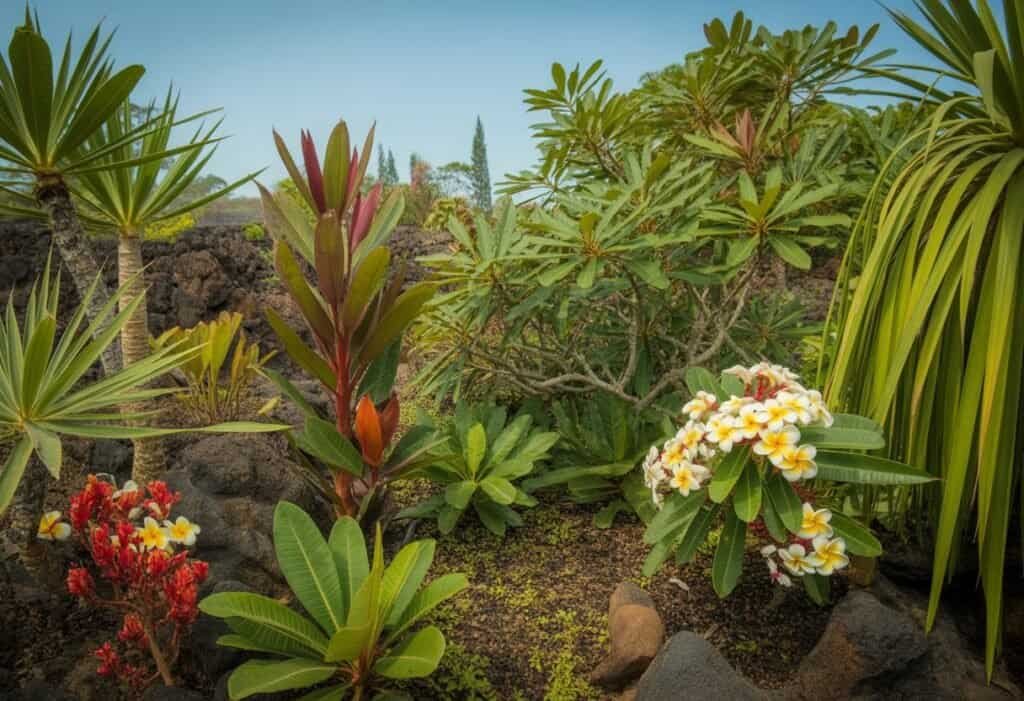Native Hawaiian plants offer a beautiful way to create sustainable, authentic landscapes that honor the islands’ natural heritage. These plants evolved over millions of years in Hawaii’s unique conditions.
Native plants adapt perfectly to thrive with minimal care once established. Using native Hawaiian plants in your landscaping helps preserve biodiversity and creates stunning gardens that connect to the islands’ cultural and ecological history.

From the elegant silversword to the vibrant ʻōhiʻa lehua, native plants bring Hawaii’s natural beauty to your doorstep. They provide habitat for native wildlife and usually need less water and maintenance than imported species.
Many native plants hold deep cultural significance. Hawaiians have used them for generations in medicine, crafts, and ceremonies.
Key Takeaways
- Native Hawaiian plants are drought-tolerant and low-maintenance while providing authentic island beauty in home landscapes.
- Using indigenous plants helps preserve Hawaii’s biodiversity and creates natural habitats for native wildlife species.
- Native gardens connect homeowners to Hawaiian cultural heritage while reducing water usage and maintenance requirements.
Understanding Native Hawaiian Plants
Native Hawaiian plants evolved in isolation over millions of years. This process created unique species found nowhere else on Earth.
These plants adapted to Hawaii’s diverse ecosystems, from coastal areas to high mountain zones.
Definition and Classification
Native Hawaiian plants include species that arrived in Hawaii without human assistance and those brought by early Polynesian settlers. The islands’ native flora contains about 1,400 vascular plant species.
About 90% of these plants are endemic, meaning they exist naturally only in Hawaii.
These plants fall into several categories based on their growth habits. Trees like the Koa and Ohia Lehua form the backbone of native forests.
Shrubs such as the Naupaka thrive in coastal areas. Native Hawaiian flowers include the striking Hibiscus brackenridgei (Hawaii’s state flower) and various lobelias.
Native plants have adapted to specific environmental conditions. Some thrive in wet forests, while others evolved to survive in dry, volcanic landscapes.
Endemic Versus Polynesian-Introduced Species
Endemic species arrived in Hawaii through natural means like wind, water, or birds before human contact. These plants evolved in isolation for millions of years and developed unique characteristics.
The silversword, for example, adapted to harsh volcanic conditions at high elevations on Maui and Hawaii Island.
Polynesian-introduced plants arrived with early Hawaiian settlers around 1,500 years ago. These “canoe plants” include useful species like kukui (candlenut), ‘ulu (breadfruit), and mai’a (banana).
While not endemic, these plants are considered culturally native and played crucial roles in traditional Hawaiian life.
Endemic plants face greater extinction risks due to their limited range and specialized adaptations. Both endemic and Polynesian-introduced groups contribute to Hawaii’s ecological and cultural heritage.
Benefits of Using Native Hawaiian Plants in Landscaping

Native Hawaiian plants offer unique advantages for landscaping projects. These indigenous species evolved specifically for Hawaii’s climate and soils.
Environmental Advantages
Native Hawaiian plants require much less water than non-native alternatives. Many indigenous species thrive in Hawaii’s varied microclimates without extra irrigation.
This water efficiency lowers utility bills and conserves precious resources. These plants usually need minimal fertilizers or pesticides.
Native plants like ‘ōhi’a lehua and ‘ākia grow robustly without chemical assistance. This reduces harmful runoff into streams and oceans.
Native plants help prevent erosion, especially in coastal areas. Species like pōhuehue (beach morning glory) have extensive root systems that stabilize dunes and hillsides.
Their natural growth patterns protect the land during heavy rains and high surf conditions. Maintenance needs drop dramatically with native plantings.
These species have natural defenses against local pests and diseases. They need less trimming, treating, and replacing than imported plants.
Support for Local Ecosystem
Native plants provide essential habitat for Hawaiian wildlife. Indigenous birds like the ‘i’iwi and ‘apapane depend on nectar from native flowers.
Hawaiian yellow-faced bees collect pollen from local blooms. Gardens with these plants directly support endangered species.
Many Hawaiian plants evolved alongside specific pollinators, creating interdependent relationships. Non-native plants cannot replace these connections.
Indigenous plants help restore balance to fragmented ecosystems. Pockets of native plantings create corridors for wildlife movement and genetic exchange.
Native plantings attract natural pest controllers. Birds and beneficial insects that feed on garden pests visit landscapes featuring familiar plants.
This creates a healthier, more balanced garden ecosystem.
Cultural Significance
Hawaiian plants hold deep cultural importance in traditional practices. Many species like maile, lehua, and ti leaf play central roles in lei making, hula, and ceremonial activities.
Using these plants in landscapes helps preserve these cultural connections. Native plants tell stories of Hawaiian history and values.
Each plant has associated mo’olelo (stories) and ‘ōlelo no’eau (proverbs) that carry cultural wisdom. Landscapes featuring these plants become living libraries of Hawaiian knowledge.
Indigenous plants create a sense of place that honors Hawaii’s unique identity. Rather than generic tropical landscapes, native plantings celebrate what makes Hawaii special.
Using native plants supports cultural practitioners who depend on these resources. As more landowners include indigenous species, sustainable harvesting opportunities increase for those practicing traditional arts.
Popular Native Hawaiian Plants for Landscaping

Hawaiian landscapes benefit from native plants that have evolved to thrive in the islands’ unique conditions. These plants need less maintenance, support local wildlife, and preserve Hawaii’s botanical heritage.
Flowering Species
The Hawaiian hibiscus (Hibiscus arnottianus) stands out with its fragrant white flowers and red stamens. As Hawaii’s state flower, it makes a stunning focal point in any garden.
‘Ōhi’a lehua (Metrosideros polymorpha) produces red, orange, or yellow pom-pom shaped flowers that attract native birds. This sacred plant adapts to various elevations and conditions across the islands.
‘Ilima (Sida fallax) bears small orange flowers traditionally used for lei-making. Its drought tolerance makes it perfect for sunny, dry locations.
Hibiscus furcellatus (bush hibiscus) displays delicate pink to lavender blooms in wet areas. This rare native species adds unique color to rain gardens or pond edges.
Trees and Shrubs
Koa (Acacia koa) grows into a majestic tree with distinctive crescent-shaped leaves. Its beautiful wood has been used for canoes and furniture for generations.
Popular Native Hawaiian Shrubs:
- ‘A’ali’i (Dodonaea viscosa): Produces colorful seed capsules in red, pink, or yellow
- Naio (Myoporum sandwicense): Features fragrant white flowers and dense foliage
- Kou (Cordia subcordata): Bears orange flowers and provides excellent shade
- Nanu (Gardenia brighamii): Offers intensely fragrant white blooms
Loulu palms (Pritchardia species) add tropical character with their fan-shaped fronds. These endangered native palms come in several varieties suited to different island microclimates.
Hau (Hibiscus tiliaceus) creates natural privacy screens with its yellow flowers that turn orange-red as they age.
Ground Cover Options
Pōhinahina (Vitex rotundifolia) spreads along the ground with silvery foliage that contrasts beautifully against dark mulch. Its purple flowers attract beneficial insects.
‘Ākulikuli (Sesuvium portulacastrum) works well in coastal landscapes with its succulent leaves and pink flowers. This hardy plant tolerates salt spray and sandy soils.
‘Uki’uki (Dianella sandwicensis) produces blue berries after its delicate white flowers fade. Its grass-like foliage adds texture to garden borders.
Pā’ū-o-Hi’iaka (Jacquemontia sandwicensis) creates a beautiful carpet of small morning glory-like blue flowers. This endangered plant excels in sunny, dry locations where it can spread freely.
‘Ilie’e (Plumbago zeylanica) features clusters of white flowers and grows naturally in dry to mesic forests. It establishes quickly in garden settings.
Designing Hawaiian Gardens with Native Plants
Native Hawaiian plants can transform your landscape into a beautiful, sustainable garden that honors the islands’ natural heritage. Creating a garden with these plants requires thoughtful planning about layout, color combinations, and water conservation techniques.
Garden Layout Principles
When designing Hawaiian gardens, start by mapping sunny and shady areas in your yard. Native plants like ‘ōhi’a lehua thrive in full sun, while ferns prefer shadier spots.
Group plants with similar water needs together. This practice, called hydrozoning, makes irrigation more efficient and helps plants thrive.
Consider mature plant sizes when planning. The ‘ōhi’a can grow 25-40 feet tall, while ground covers like ‘ākulikuli stay under 6 inches.
Leave appropriate spacing between plants to prevent overcrowding. Create flowing, natural-looking arrangements rather than rigid rows.
This mimics how plants grow in nature and creates a more authentic Hawaiian garden feel. Add pathways using local materials like lava rock or crushed coral to make garden areas accessible and define spaces.
Color and Texture Selection
Hawaiian gardens shine with vibrant colors and varied textures. Red ‘ōhi’a lehua flowers create stunning focal points, while yellow ma’o (Hawaiian cotton) adds sunny highlights.
Color combinations to consider:
- Red ‘ōhi’a with green māmaki for classic contrast
- Purple ‘akulikuli with silver-green hinahina for beach-inspired themes
- Yellow ‘ilima with blue-green pōhinahina for subtle harmony
Texture adds visual interest to your garden. Mix feathery ferns with broad-leaved taro and spiky ‘uki’uki for dimensional contrast.
Layer plants of different heights. Place taller plants like loulu palms in the background, medium shrubs in the middle, and ground covers in front for a complete landscape look.
Xeriscaping for Water Conservation
Hawaiian gardens benefit from xeriscaping principles, especially in drier areas. Many native plants evolved in challenging conditions and naturally need less water once established.
Choose drought-tolerant natives like ‘ilima, ‘āweoweo, and wiliwili for areas that receive little rainfall. These plants develop deep root systems to survive dry periods.
Apply 2-3 inches of mulch around plants to retain soil moisture and reduce evaporation. Mulch also suppresses weeds and adds nutrients as it breaks down.
Install efficient drip irrigation systems that deliver water directly to plant roots. This reduces waste and prevents leaf diseases caused by overhead watering.
Minimize lawn areas, which require significant water. Replace grass with native ground covers like ‘ākulikuli or ‘ilie’e that thrive in the tropical climate while using less water.
Planting and Maintenance Strategies
Native Hawaiian plants thrive with proper planting techniques and care routines that respect their natural growing conditions. These plants have adapted to Hawaii’s unique environment and need specific approaches to soil preparation, watering, and maintenance.
Soil and Site Preparation
Hawaiian native plants evolved in volcanic soil with excellent drainage. Before planting, test your soil pH; most native species prefer slightly acidic to neutral conditions (5.5-7.0).
Amend heavy clay soils with cinder, perlite, or coarse sand to improve drainage. Choose planting locations based on each species’ natural habitat.
Coastal plants tolerate salt spray and wind. Forest species need protection from strong winds and direct afternoon sun.
Preparation steps:
- Dig holes twice as wide as the root ball but only as deep.
- Mix existing soil with compost (about 25% compost).
- Avoid excessive amendments that might shock native plants.
- Space plants properly to allow for mature growth.
On slopes, create terraces or swales to prevent erosion and capture rainwater.
Watering and Fertilization Needs
Most native Hawaiian plants need minimal supplemental water once established. New plantings need regular watering for 3-6 months until roots develop.
After roots establish, gradually decrease watering. Water deeply but infrequently.
Allow soil to dry slightly between waterings. Adjust frequency based on rainfall and season.
Use drip irrigation to conserve water. Fertilize sparingly, since native plants evolved in nutrient-poor volcanic soils.
Apply a light application of slow-release organic fertilizer once yearly in spring. For container plants, use a half-strength fertilizer solution every 2-3 months.
Watch for yellowing leaves, which can signal nutrient deficiencies needing minor adjustments.
Pruning and Pest Control
Hawaiian native plants need little pruning. Remove dead or damaged branches and lightly shape plants as needed.
Avoid heavy pruning during hot, dry periods or while plants are flowering. Prune flowering shrubs after blooming and trim groundcovers in early spring.
Remove seed heads if you want to prevent self-seeding. Native plants usually have fewer pest problems than introduced species.
Watch for common issues like aphids, mealybugs, or scale insects. Use organic controls first, such as insecticidal soap or neem oil.
Keep plants spaced properly for good air circulation. Avoid overhead watering to reduce disease risk.
Remove diseased plant material promptly to prevent spread.
Addressing Invasive Species and Ecosystem Protection
Invasive species threaten Hawaii’s delicate ecosystem by outcompeting native plants and disrupting natural balances. Identifying these threats and using proper prevention strategies are essential for gardeners.
Common Invasive Threats
Strawberry guava (Psidium cattleianum) forms dense thickets that crowd out native plants and use excessive groundwater. Fountain grass (Pennisetum setaceum) spreads quickly by wind-dispersed seeds and increases fire risks.
Miconia (Miconia calvescens), called the “purple plague,” has large leaves that block sunlight from reaching native plants. A single tree can produce millions of seeds each year.
Other significant threats include:
- Australian tree fern
- Ivy gourd
- Koster’s curse
- Banana poka
These invasives often escape from gardens and invade natural areas, causing lasting damage.
Best Practices for Prevention
Select plants carefully and check that none are on Hawaii’s Noxious Weed List before buying. Monitor your garden regularly to catch invasive seedlings early.
Remove suspicious plants right away before they can spread. Create buffer zones, such as gravel paths or mulched areas, between landscaped spaces and natural habitats.
When removing invasives:
- Pull plants before they seed.
- Bag and dispose of all plant material properly.
- Clean tools and shoes afterward to prevent spreading seeds.
Support local native plant nurseries for expert advice and healthy, appropriate species.
Sourcing Native Hawaiian Plants
Careful sourcing ensures you get healthy Hawaiian plants and helps preserve native populations. Choose nurseries that specialize in indigenous species and provide proper documentation.
Selecting Reputable Nurseries
Look for nurseries certified by the Hawai’i Conservation Alliance or similar organizations. These nurseries usually maintain high standards for plant health and genetic authenticity.
Many reputable nurseries include:
- Hui Kū Maoli Ola (O’ahu)
- Native Nursery (Maui)
- Future Forests Nursery (Big Island)
- Kaua’i Native Plant Society (Kaua’i)
Before buying, ask staff about how they collect seeds and cuttings. Make sure you understand the growing conditions each plant needs.
Sustainable Propagation Methods
Sustainable propagation protects wild plant populations. Ethical collection means taking only what you need and avoiding harm to parent plants.
Collect seeds during the right season for each species. Some Hawaiian plants require special treatment, like scarification or cold stratification, for germination.
Take cuttings during active growth periods. Use clean, sharp tools and treat cut ends with rooting hormone.
Keep cuttings humid until roots form. Start with easier species like ‘ākia or ‘ilima before trying more challenging plants like loulu palms or native ferns.
Native Plant Reference Table
This table offers key details about native Hawaiian plants suitable for landscaping. Use it to choose the right plants for your garden.
| Common Name | Scientific Name | Height | Sun Needs | Water Needs | Special Features |
|---|---|---|---|---|---|
| ʻŌhiʻa Lehua | Metrosideros polymorpha | 20-80 ft | Full to partial sun | Moderate | Red, orange, or yellow flowers; attracts birds |
| Naupaka | Scaevola taccada | 3-10 ft | Full sun | Low to moderate | White fan-shaped flowers; salt tolerant |
| ʻIlima | Sida fallax | 1-3 ft | Full sun | Low | Orange-yellow flowers; drought resistant |
| Kou | Cordia subcordata | 15-30 ft | Full sun | Moderate | Orange trumpet flowers; shade tree |
| Pōhinahina | Vitex rotundifolia | 1-2 ft | Full sun | Low | Silver-gray foliage; purple flowers |
| ʻAkiʻaki | Sporobolus virginicus | 6-12 in | Full sun | Low | Sturdy grass; good for erosion control |
| ʻĀkulikuli | Sesuvium portulacastrum | 6-12 in | Full sun | Low | Succulent groundcover; pink flowers |
| Maiapilo | Capparis sandwichiana | 1-3 ft | Full to partial sun | Low | Fragrant white flowers; night blooming |
| Hala | Pandanus tectorius | 20-30 ft | Full sun | Moderate | Distinctive prop roots; textural accent |
| ʻŪlei | Osteomeles anthyllidifolia | 2-6 ft | Full sun | Low | White flowers; blue-black berries |
These plants have adapted to Hawaii’s unique conditions over thousands of years. They usually need less maintenance than non-native plants.
Most native plants benefit from mulching and initial care until established. After that, they need little attention.
Frequently Asked Questions
Native Hawaiian plants provide unique benefits for landscaping across the islands. They have adapted to local conditions, making them resilient and low-maintenance.
What are the top low maintenance native Hawaiian plants suitable for landscaping?
Several native Hawaiian plants need little care once established. ʻĀkia (Wikstroemia uva-ursi) works well as a ground cover in coastal areas with little water.
Pōhinahina (Vitex rotundifolia) has silvery-gray foliage and purple flowers. It needs infrequent watering after establishment and tolerates salt spray and drought.
ʻAʻaliʻi (Dodonaea viscosa) grows as a shrub or small tree with colorful seed capsules. It adapts to various soils and needs only occasional pruning.
Which native Hawaiian plants are ideal for small-scale gardens and landscapes?
ʻŪlei (Osteomeles anthyllidifolia) fits well in small spaces as a compact shrub with white flowers and small fruits. It usually stays under three feet tall.
Naio papa (Myoporum sandwicense) grows as a low-lying shrub and works well as ground cover in limited spaces. Its small white flowers attract pollinators.
Pili grass (Heteropogon contortus) adds texture and golden color to small gardens. This bunch grass requires minimal care.
Can you list five popular native Hawaiian plants commonly used in landscaping?
Naupaka kahakai (Scaevola taccada) has distinctive half-flowers and thrives in coastal landscapes. Its salt tolerance makes it popular for oceanfront gardens.
Koki’o ke’oke’o (Hibiscus arnottianus) produces fragrant white flowers year-round. This native hibiscus creates a striking focal point.
Ilima (Sida fallax) bears orange-yellow flowers used for lei-making. It adapts well to gardens and attracts butterflies.
Kou (Cordia subcordata) is a medium-sized tree with orange flowers and provides excellent shade. Its wood was traditionally used for bowls.
Loulu palms (Pritchardia species) have fan-shaped fronds and come in various sizes for different spaces.
What are some native Hawaiian plants that thrive in Oahu’s landscaping conditions?
Alaheʻe (Psydrax odorata) grows well in Oahu’s varied microclimates with glossy leaves and fragrant flowers. It tolerates both wet and dry conditions.
ʻIliahi (Santalum species), or Hawaiian sandalwood, adapts to Oahu’s diverse environments. These trees produce fragrant wood and can serve as landscape specimens.
Maʻo (Gossypium tomentosum) thrives in Oahu’s sunny, dry areas. This native cotton relative has yellow flowers and silvery foliage.
Kulu’i (Nototrichium sandwicense) handles Oahu’s dry, rocky areas. Its silvery spikes and drought tolerance make it valuable for xeriscaping.
How can native Hawaiian plants be utilized effectively in landscape design?
Group plants with similar water needs together to create efficient watering zones. This approach, called hydrozoning, prevents overwatering drought-tolerant natives.
Use native plants at different heights for visual interest. Combine trees like ohia lehua with mid-height shrubs and ground covers to create natural layers.
Restore habitat function by selecting species that provide food and shelter for native birds and insects. Themed gardens based on Hawaiian plant communities—coastal, dry forest, or wetland—showcase how these plants grow together naturally.
Where can I find a comprehensive list of native Hawaiian plants, including images and usage tips?
The University of Hawaiʻi’s College of Tropical Agriculture maintains extensive resources on native plants. Their website includes photographs, growth requirements, and landscape applications.
The Native Hawaiian Plant Society offers detailed guides and plant lists. Their resources include specific information about cultivation and traditional uses.
Local botanical gardens such as Waimea Valley and Lyon Arboretum display native plants with interpretive information. These gardens show how native plants perform in landscape settings.
The Hawaiʻi Native Plant Propagation Database provides searchable information on propagation methods and growing conditions. This database helps gardeners grow native species successfully.


